After more than a decade of experience with men’s fashion illustrations, I still find new styles and interesting details regularly. The other day, I flipped through a German Herrenjournal from 1937 and I found some very interesting overcoats with fur collars along with other details that I would like to share with you.
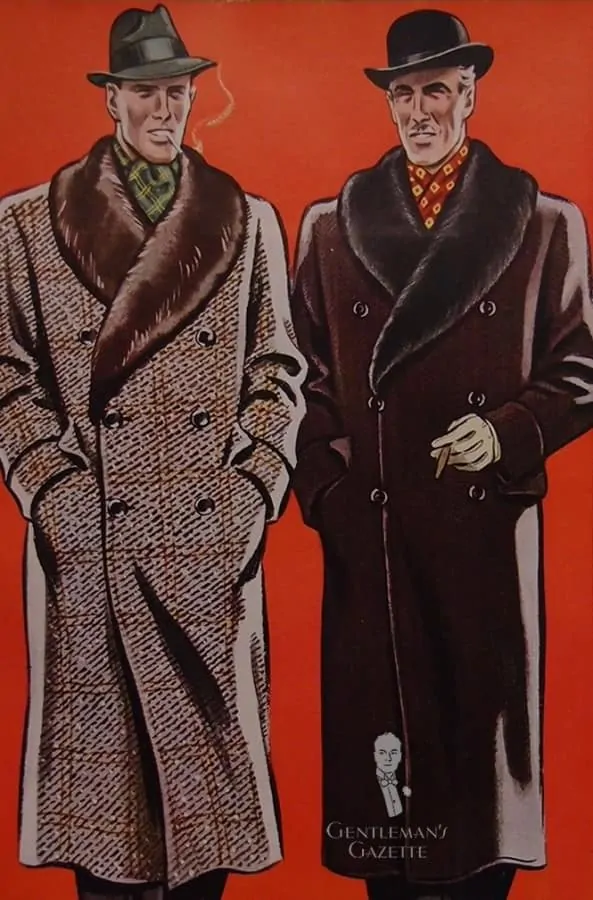
Men’s Overcoats with Fur Collars
First, let’s take a look at these two beautiful double breasted overcoats with fur collars. Personally, I wear double breasted overcoats almost exclusively since they suit my built and silhouette, and they look dressier in my opinion. Although I do own a double breasted beaver fur coat, I have never really found an overcoat with just a fur collar and/or fur lining that I liked. However, a fur collar on an overcoat doesn’t just look stunning but it also makes you feel much warmer. That’s why I am always on the lookout for fur collars, which I then have attached to my overcoat. That way I can find the right coat, and look for a specific fur. Of course, when buying these fur collars, you should ideally have your overcoat with you so you know howit fits in terms of size. At he very least you should know the measurements. When in doubt, go with something that is a little bigger, because it doesn’t matter if it extends beyond the lapels but it is unwearable if you can see the lapel peaking out from underneath the fur collar. If you want to learn how to buy and maintain fur, take a look here.
Traditionally, these men’s overcoats also had a full fur lining and hence they are perfect for cold winter days. If you take a closer look, you will notice that the gentleman on the left has a classic button closure that you will find on modern overcoats today, whereas the gentleman on the right has the buttons on the hem of his charcoal brown overcoat. This buttoning style was popular in the 1920’s especially with fur over coats. People like Rudolph Valentino had many coats like that. Today, it’s a hallmark of a vintage overcoat. As you can see in the picture, green and red tones work beautifully with brown tones, and I encourage you to wear interesting colors in winter to break the monotony of charcoal grey, black and navy outerwear witnessed allover the place. A fur collar and a little bit of color will be a unique way to do this and considering that a collar costs often not more than $40 -50, it is a very inexpensive option to upgrade your overcoat. Should you not grow tired of the look after a few seasons, you can simply remove it with a seam-ripper, and add it to another coat for a different look.
Personally, I would love to wear either of those coats because a shawl collar lapel on a DB overcoat is special and different from anything else. Note, nobody in the 1930’s ever wore black or really dark gloves, instead they always went with light, interesting and somewhat contrasting colors.
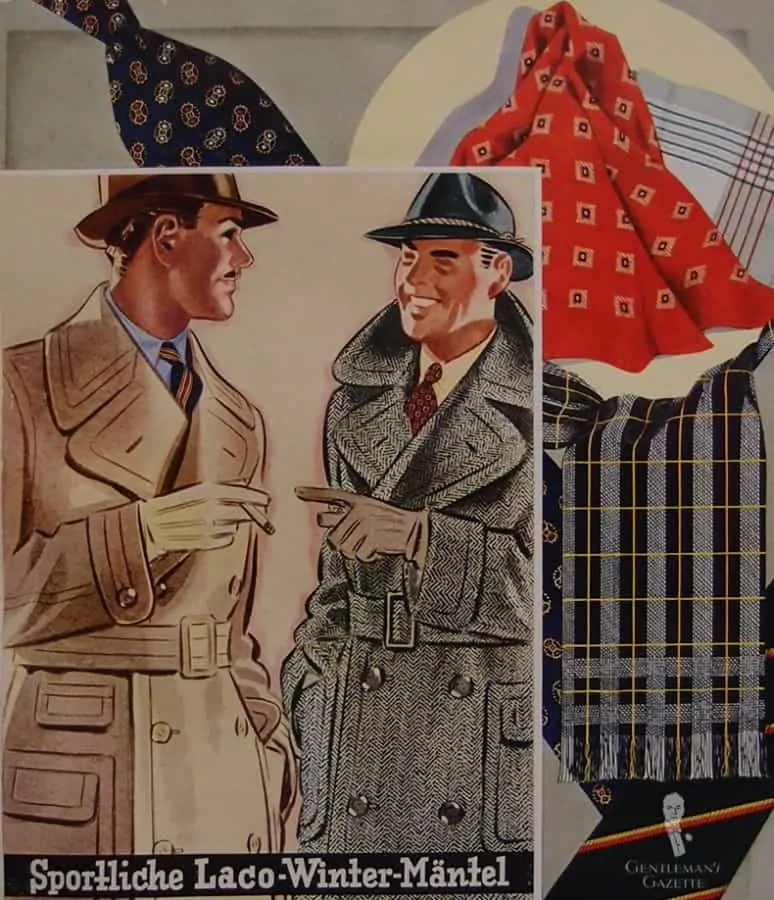
Ulster Overcoats
Ulster overcoats are hugely underrated in my opinion and rarely seen anymore. Most of the time you must visit a bespoke tailor to get one, especially if you are keen on details such as the ticket pocket or a special cuff as seen in the illustration above. For more details about this overcoat style, please take a look at my Ulster Guide. Once again, gloves are pale grey and yellow, not black or mid-brown. Also, note the difference in illustration technique between the prior and following illustration. The top one shows unreal men with small heads and super long torsos. The second illustration is less extreme, whereas the following illustration is soft and rather realistic in terms of proportion.
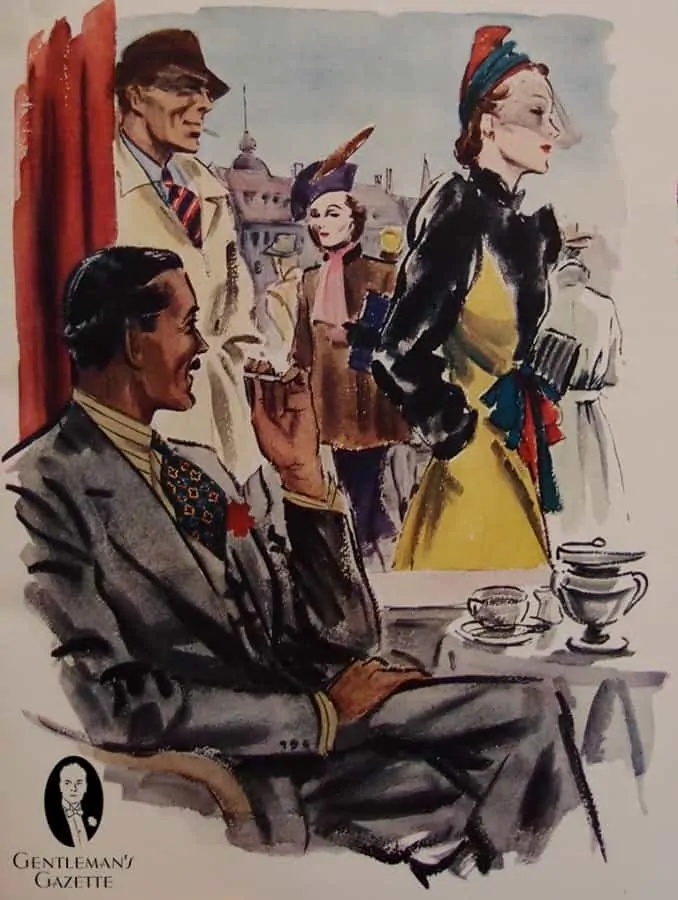
The man outside wears a trench coat or overcoat in a light beige color. Today, most men would shy away from such a light shade because it gets dirty rather quickly, though when combined well with some brighter or darker, contrasting accessories it looks rather debonair. On another note, look at the suit ensemble of the man sitting inside. He wears a collar pin with boutonniere and his jacket sleeve cuffs feature three buttons even though he has a vest. Nowadays most jackets have 4 buttons and most guides will tell you that 4 are more formal than three, yet this three piece suit, which would be considered rather formal these days just had 3. In fact, I have old tailcoats and morning coats, which are very formal garments and they just have two cuff buttons. It seems like back in the day 2 or 3 buttons were also used for more formal garments in continental Europe and the U.S.
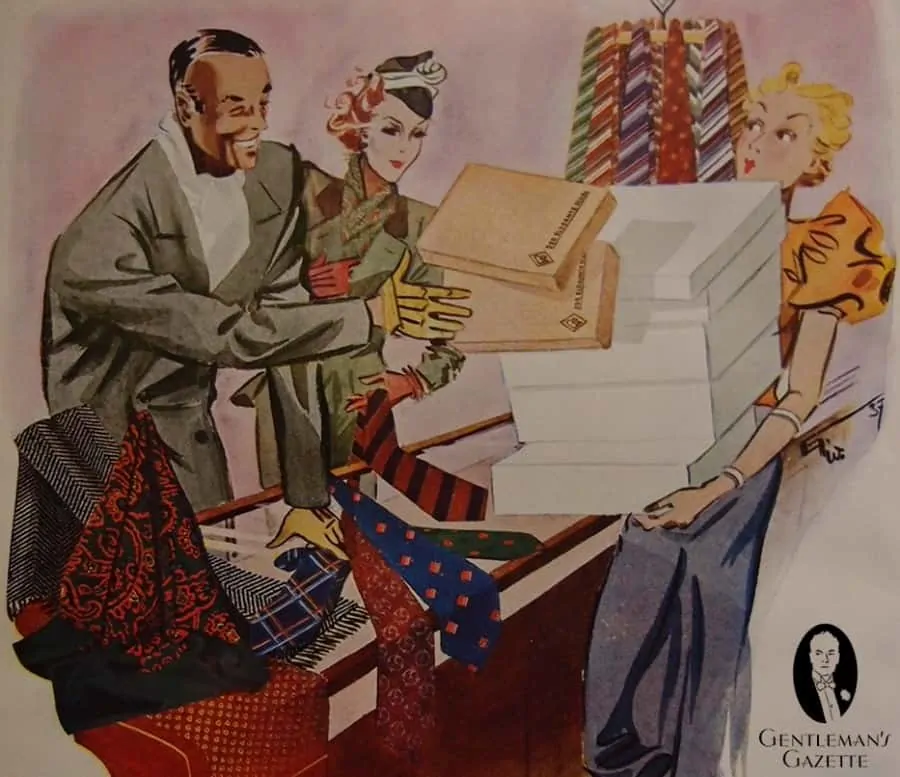
I like the picture above because it shows a man wearing three things, none of which are commonly seen anymore.
1. The light grey overcoat. It’s versatile and can be worn with business clothes and casual combinations alike. It is not too dark, yet it doesn’t get dirty easily and because of its versatility and dirt resistance it makes for an ideal travel piece.
2. The white , off white or winter white scarf. Today, you see scarves in this color only at formal evening events and then it is more of a decorative accent rather than a functional piece of one’s wardrobe. It’s true that a white scarf stains more easily but that was exactly the reason why fine gentleman used to wear a lot of white. It showed that they were rich enough to afford a large wardrobe and that they were able to change, so their gloves and shirts were always white.
3. Chamois yellow gloves: very hard to find nowadays yet so versatile and elegant. For that reason, I decided to design my own gloves lined and unlined in this beautiful shade of yellow.
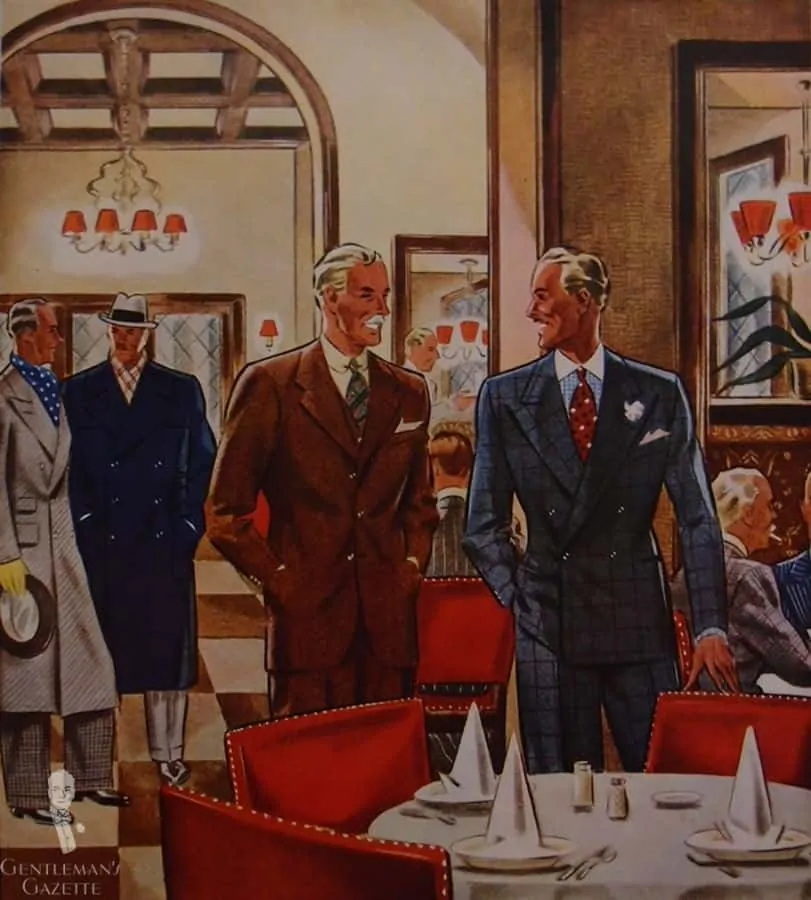
I don’t know where you would have to go nowadays to find a group of men at lunch dressed equally as elegant as in this pictures. In the foreground, we see an interesting drape cut grey flannel windowpane suit with bordeaux checks in a 4×1 Kent silhouette with white boutonniere and winchester shirt. On the left, we see a SB brown suit with a vest, worn with a pale yellow shirt with collar pin and tie. Note, the sleeves have just three buttons on either sleeve. In the background we see two gentleman in overcoats and scarves. In my opinion, this light grey overcoat is even better than the solid one from the illustration above because it has this strong diagonal twill rib effect that provides the garment with unique character without sacrificing its versatility. It is paired with a checked suit, dark shoes, a hat, blue polka dot scarf and chamois yellow gloves. The other gentleman wears a navy overcoat with a checked scarf and grey Homburg hat.
Stylistically, these drawings are once again slightly different, although the proportion issue of small heads with long bodies remains obvious.

Last bot not least, two great suits. First, a dark brown double breasted suit with a blue overcheck. To balance the dark suit, he chose a pastel yellow shirt with collar pin and a striped navy silk tie.
The other gentleman wears a three piece, mid-grey diagonal flannel suit with the same tie and a light grey winchester shirt with red boutonniere and pocket square. Although both suits are quite different the tie works very well in both cases. Back in those days, fabrics were really heavy and they tailored up more easily than today, in the sense that they showed fewer wrinkles and better drape. At the same time, the finishing was way worse than today. I would love to see a fabric in grey with big diagonal ribs with a heavier weight but modern day finish again. I am certain it would make up for a splendid suit or overcoat. Also, solid pastel colored shirts are one of the most underrated items in classic menswear today. Especially when paired with a white contrast collar, light red, violet, green, orange, yellow or grey can look stunning on men, yet most men are stuck with white, light blue and maybe some pink.
Stylistically this drawing displays a bit less detail though I love the fact that it highlights the versatility of the tie. Also, the proportions seem much better, although the hand seems rather large.
Overall, I found it quite interesting to see the variety of styles in illustration in the very same issue. Unfortunately, hardly anybody understand how to draw that way anymore and even if they do, chances are they lack the attention to detail which is needed to create drawings of this caliber.
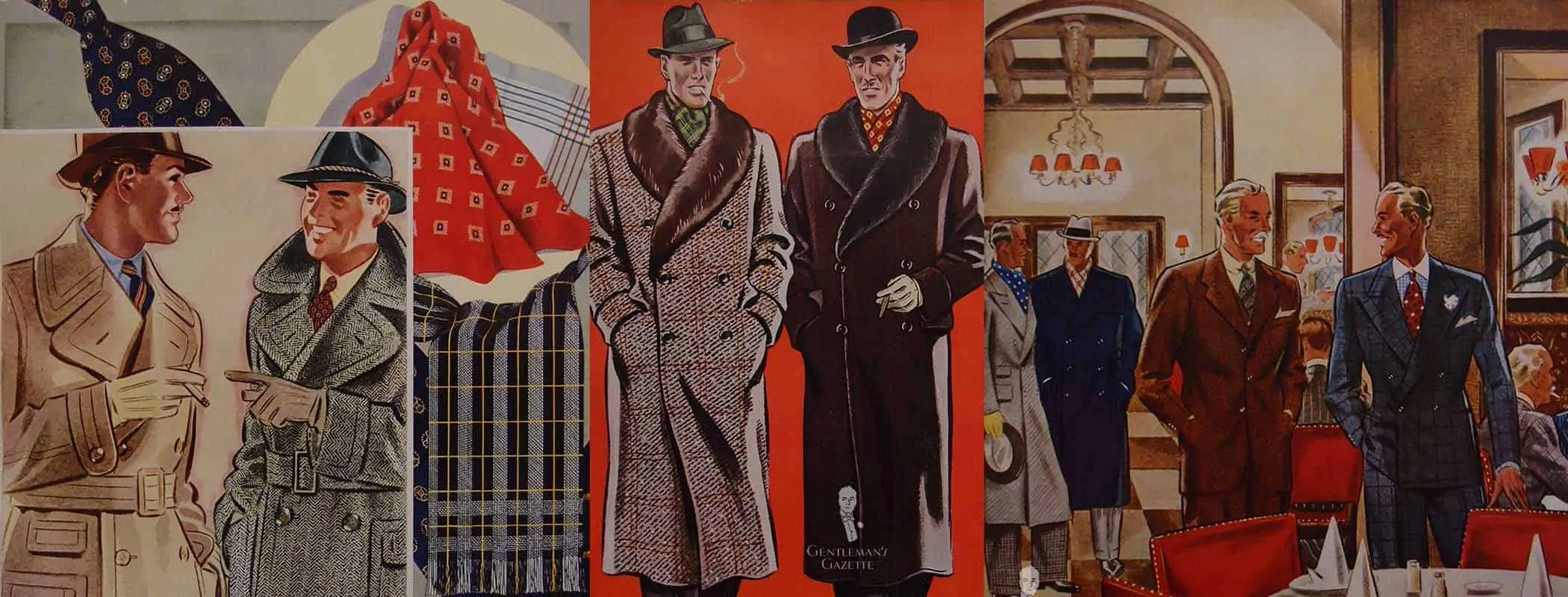
Sven:
Love this topic. I’m looking to find a particular overcoat/raincoat of the style worn by Fred Astaire in the film “Funny Face”. It is rather simple in design but has an enticing collar button. I remember wearing my grandfathers overcoat with this same button cross collar closing mechanism but have not seen it in years. Any idea what this style is called? I have a link to a still photo from the movie below. Movie has great soundtrack and is an awesome photoplay of Paris in the 50s. Audrey Hepburn too. It’s not Citizen Kane, but worth a viewing for sartorial styling.
Best regards,
http://media-cache-ak0.pinimg.com/736x/9e/7c/2e/9e7c2e6801a48f193053c183c7f1ffdc.jpg
As far as I can see, it looks like a normal Mackintosh style raincoat, with the collar flipped up, like in the picture below:
http://s7.thisnext.com/media/largest_dimension/599A58DE.jpg
And indeed, the film is very well-dressed, but one should never expect less when Astaire is involved!
It’s a raglan sleeve raincoat. The distincitve feature is a double throat latch behind the collar, made of the same red plaid fabric as the lining.
E: thanks. Not sure if I can find one anywhere, but I’d like to.
Beautiful illustrations you found here, Sir.
Notice what appears to be a link closure on the gray twill suit in the last picture.
great illustrations, thanks; in particular, the brown windowpane double breasted suit is fantastic. why not follow this style? I’m sure that also nowaday a DB 2+2 buttons is a great option instead the usual Db.
Hello and thank you for the article. I always enjoy the drawings from the 1930 magazines. I have a single breasted Chesterfield overcoat in black cashmere. What colour and what animal would you recommend for a collar?
Maybe something in golden brown or silver grey.
Thank you. I first thought of black mink as a safe bet, but a colour contrast would surely be more eye catching. The furrier suggested fisher (martes pennanti). I will mention your suggestions to him.
Best regards from Paris
I’ve been looking for a double breasted, full-length wool overcoat with a fur collar just like the ones sown in the picture up tp. Do you know if anyone makes that type of coat and where I could find one? Thanks, Joe